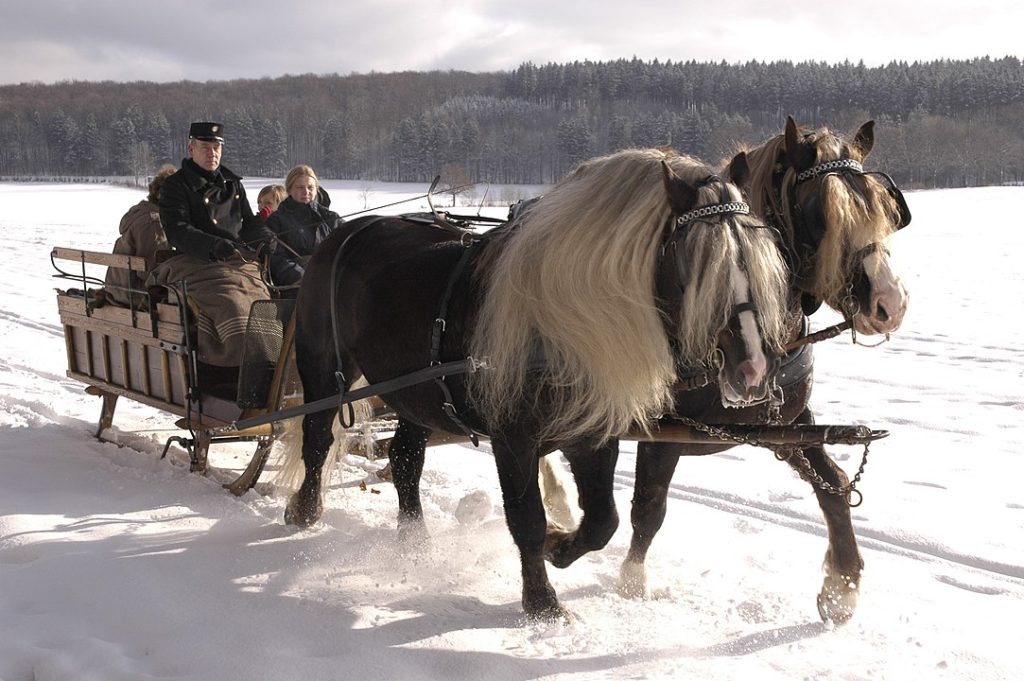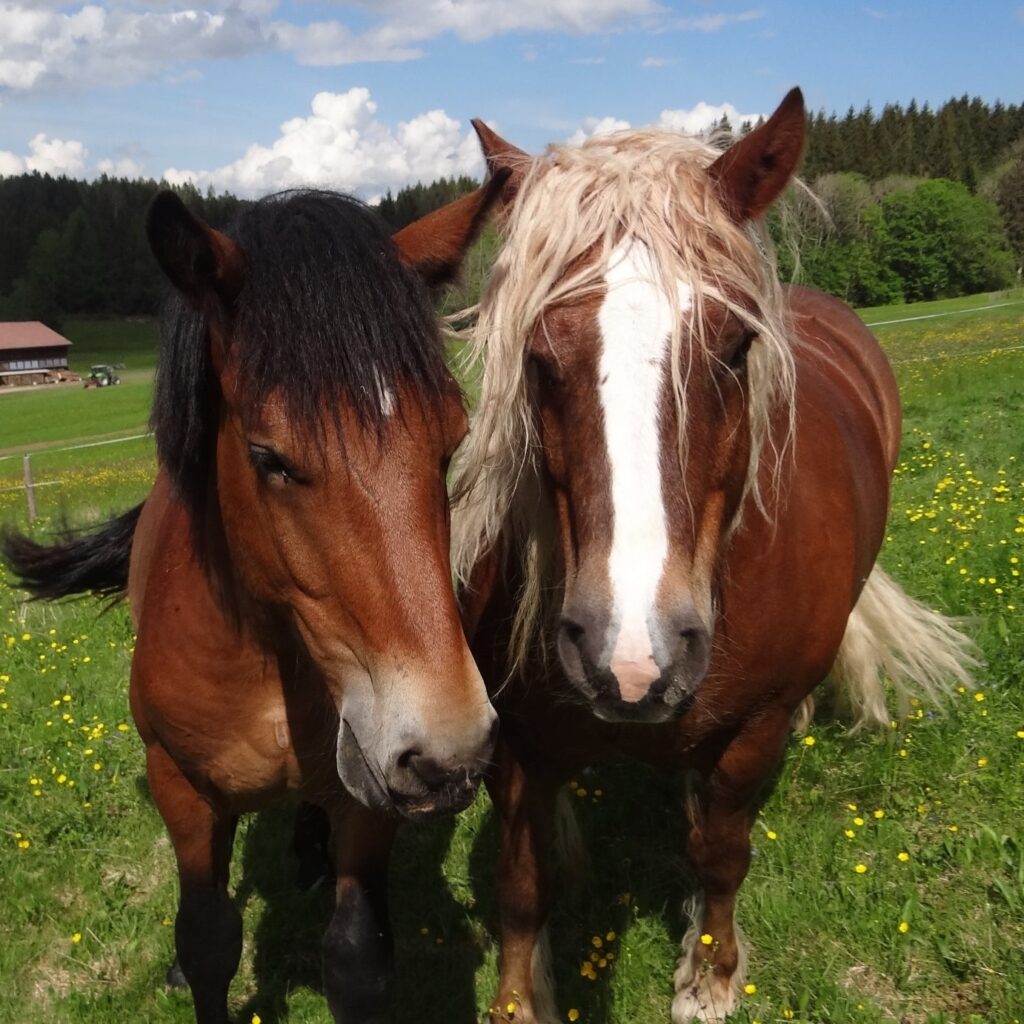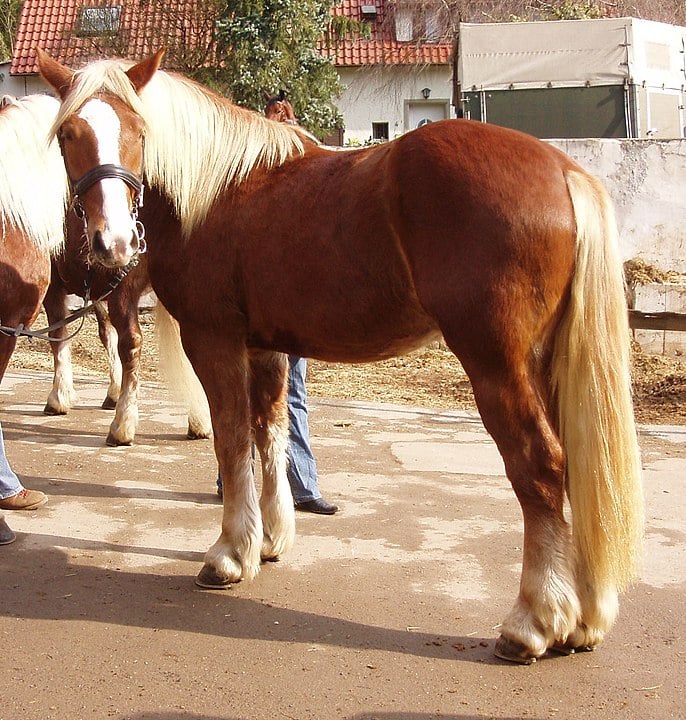Last updated: May 29, 2025
The Black Forest horse breed originated from a thickly wooded region of Germany. The region is famous for its natural beauty, cuckoo clocks, and the unique horse breed that evolved from the territory, the Black Forest draft horse.
Black Forest horses are a hardy breed with a chestnut coat and flaxen mane and tail. They are powerful horses bred to work in the harsh conditions of the Black Forest region.
Many horse enthusiasts are familiar with oversized draft horse breeds. However, most are not as learned about this smaller draft breed called the Black Forest draft horse.
Black Forest draft horse breed facts and history.
Worldwide the Black Forest Horse is rare, and the majority still live in the region of their origin, Baden-Württemberg, in southwestern Germany. It’s estimated that there are 1,200 purebred Black Forest horses globally, and Baden-Württemberg boasts a population of seven hundred of the breed.

The regional stud farm “Haupt und Landgestüt Marbach” houses 20 of the 50 Black Forest stallions in all of Germany. The Black Forest area is a cold, densely tree-covered, and mountainous region.
The uniques characteristics of the horses from this region enabled them to live, work, and thrive in the harsh environment. The Black Forest is the highest part of the Scarplands in southern Germany.
The area is dominated by mountains, dense forests, and fertile valleys. The forest is over 100 miles long and 30 miles wide. Records of horse breeding in the region were traced to the Abbey of Saint Peter in the 15th century.

Breeding facilities associated with monasteries were commonplace in this period because of the monks’ record-keeping ability. The breed that the local horses trace its origins to is the Walderpferd.
The Walderpferd was a massive horse used in forestry and farming. The Waldepferds are the ancestor of the modern Black Forest horse. Through the years, farmers began to breed these Waldepferd mares to lighter stallions.
These horses evolved into a lighter draft breed that was suitable to handle the harsh cold and rocky terrain of the region. The new breed developed into the Black Forest horse breed, also called the Schwarzwalder Fuchs, Schwarzwalder Kaltblut, or Saint Margener horse.
In the late 1800s, a breed-association was formed to standardize the breed. The breed flourished as a reliable farm and forestry draft horse. However, as machines took over more agricultural tasks, the horse’s usefulness diminished.
Their population dropped rapidly from 1200 breeding mares registered shortly after World War II to less than 160 in 1977. Today the breed is considered “endangered” and is at risk of extinction.
Since this special draft breed was displaced from the farms, they’ve been primarily used as a coach and riding horse. Most Black Forest horses are still bred in the region from which they originate.
The breed is still relatively small in numbers, having only 46 state-approved stallions standing at the stud farm in Marbach/Baden-Wurttemberg and only 700 registered mares in Germany.
Black Forest horse breed characteristics.
These small draft horses have the temperament of most draft breeds; they are gentle, intelligent, and easy to train. These horses are loyal animals that like people and are safe around children.
Although they are cold-blooded draft horses, they are not large. These small draft horses typically stand between 14.2 and 15.3 hands tall and weigh 1250 to 1400 pounds.
They have a medium frame with a robust body, sloping shoulders, and powerful broad hindquarters with healthy, hardy hoofs. Unlike some other cold-breeds such as the Friesian, they don’t have feathering on their lower legs.
The Black Forest horse is known for being durable and strong while remaining agile and lively. They are hardy horses and easy keepers.
Colors of Black Forest horses.
To be accepted in the registry, Black Forest horses must be chestnut or sorrel with a flaxen mane and tail. This is referred to as fox color in Germany.

I corresponded with Elke Rosewich, a Black Forest Horse breeder in Germany, and she informed me that it’s rare to find a Black Forest horse with a different color pattern than Fox color.
She further stated that there are only about thirty brown Black Forest Horses, three white, and two black Black Forest Horses globally. You can click here to visit their youtube channel and watch these amazing horses in action.
The video below is a video from their channel. It shows Black Forest horses pulling traditional carriages, and in the video is the last known black and white Black Forest horses.
Sorrel horses have a coat that resembles the color of a penny and a type of chestnut color. All sorrels are chestnuts, but not all chestnuts are sorrel. Chestnut horse coat color is reddish with no black hair.
It can range from a light shade of red, almost yellow, to liver brown, and even a deep, almost black coat. In the video, the horses with sorrel coats and flaxen manes and tails are the most prevalent color of Black Forest horses.
Some of the darker chestnut Black Forest horses are very dark and may look silver and black, but through testing these horses are almost always proven to have the chestnut genetic color coat pattern.
Are Black Forest Horses good for beginner riders?
Yes, these unique horses make excellent horses for a novice rider. The Black Forest horses’ temperament and conformation lend themselves to being a perfect horse for a beginner rider.
For a novice rider, you want a horse with patience and one that is not going to spook easily. However, you don’t want a deadhead that won’t move either. The Black Forest horse is willing to work, surefooted, and seek to please its rider.
It is also an easy keeper, hardy, and not genetically predisposed to diseases, all good traits a beginner rider and first-time horse owner. The horse is also an excellent trail riding horse for experienced riders.
Black Forest Horses are used for therapeutic riding.
Therapeutic riding is a way to introduce children and adults with special needs to horses. Riding a horse can increase a person with special needs, cognitive, physical, emotional, and social well-being.
These small horses have a gentle nature, and overall good character has earned them in many therapeutic riding facilities. For a person with disabilities, a horseback ride can improve their balance, flexibility, and muscle strength.
For children and adults with limited mobility, riding a horse gives them a sense of freedom and self-sufficiency they can’t otherwise experience. Plus riding a horse moves their body in a similar motion as walking, loosening up their muscles.
Individuals with emotional problems seem to relate to horses and create a bond that increases their self-confidence and calms their nerves. Of course, it is also an outdoor social experience.
I know of at least one alcohol and drug rehabilitation facility that uses therapeutic horses to help individuals. They assign a horse for patients to care for and occasionally ride.
The responsibility of caring for animals seems to produce positive results. When I heard of this program, my first reaction was that this is a great idea. I hope it gains traction and is applied at more treatment locations.
But even if there are zero physical benefits to the rider, it’s sure to provide a fun time outdoors.
What are Black Forest horses used for?
The Black Forest Horse is a sturdy breed that has been used for many purposes.
It was originally bred to be strong enough for difficult work in the woods or on farms – and now it’s being seen more often as a potential horse riding mount!
How long do Black Forest horses live?
Black Forest horses typically live between 25 and 30 years, which is slightly above average for most breeds of domesticated horses.
Related Articles
- The Oldenburg Horse Breed: Facts and Characteristics
- The Haflinger Horse Breed, are they suitable for beginners?
- Are Shire Horses Too Big to Ride?
Resources:
- Haupt und Landgestüt Marbach stud farm
- The official website for the Black Forest breeding association: https://pzvbw.de/de/kaltblut-kleinpferde/aktuelles/aktuelle-neuigkeiten/

About the Author: Miles Henry
Lifelong Horseman | Racehorse Owner | Published Author
Miles Henry brings over 25 years of hands-on experience training and owning Thoroughbred racehorses. Raised with Quarter Horses and Appaloosas, he’s spent a lifetime learning from horses—on the track, in the barn, and in the field. Today, he runs a small but successful racing stable in Louisiana and shares real-world insights on HorseRacingSense.com, helping horse owners, fans, and bettors navigate the sport with confidence.
📚 Books: View Miles’s books on Amazon »
🎧 Podcast Guest: Animal Tales Ep. 32 |
YouTube Interview
📩 Newsletter: Sign up for racing tips and horse care advice »
🔗 Follow Miles:
Twitter |
Facebook |
YouTube


